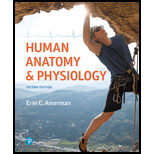
Human Anatomy & Physiology Plus Mastering A&P with Pearson eText -- Access Card Package (2nd Edition) (What's New in Anatomy & Physiology)
2nd Edition
ISBN: 9780134702339
Author: Erin C. Amerman
Publisher: PEARSON
expand_more
expand_more
format_list_bulleted
Concept explainers
Question
Chapter 19, Problem 7CYR
Summary Introduction
Introduction:
Blood is an extracellular fluid that comprises formed elements and plasma. Blood circulates throughout the body and performs almost all essential functions of the body by providing nourishment to tissues and removing byproducts of
Expert Solution & Answer
Want to see the full answer?
Check out a sample textbook solution
Students have asked these similar questions
Standard Concentration (caffeine) mg/L
Absorbance Reading
10
0.322
20
0.697
40
1.535
60
2.520
80
3.100
Please draw in the missing answer, thank you
Please fill in all blank questions, Thank you
Chapter 19 Solutions
Human Anatomy & Physiology Plus Mastering A&P with Pearson eText -- Access Card Package (2nd Edition) (What's New in Anatomy & Physiology)
Ch. 19.1 - Prob. 1QCCh. 19.1 - Prob. 2QCCh. 19.1 - 3. How does blood regulate temperature and...Ch. 19.1 - 4. What are the four main categories of plasma...Ch. 19.1 - Prob. 5QCCh. 19.2 - Describe the structure of a typical erythrocyte.Ch. 19.2 - Prob. 2QCCh. 19.2 - 3. Walk through the basic steps of...Ch. 19.2 - 4. What is the lifespan of an erythrocyte?
Ch. 19.2 - Prob. 5QC
Ch. 19.2 - Prob. 6QCCh. 19.2 - Prob. 7QCCh. 19.3 - How do granulocytes and agranulocytes differ?Ch. 19.3 - Prob. 2QCCh. 19.3 - Compare the two types of agranulocytes.Ch. 19.3 - 4. How do B and T lymphocytes differ?
Ch. 19.3 - 5. What does a monocyte become in the tissues?...Ch. 19.3 - Prob. 6QCCh. 19.3 - 7. How do the lymphoid and myeloid cell lines...Ch. 19.3 - 8. Where do T and B lymphocytes mature?
Ch. 19.4 - Prob. 1QCCh. 19.4 - Prob. 2QCCh. 19.5 - Prob. 1QCCh. 19.5 - Prob. 2QCCh. 19.5 - 3. How are platelets triggered to aggregate?
Ch. 19.5 - Prob. 4QCCh. 19.5 - How do the intrinsic/contact activation and...Ch. 19.5 - Prob. 6QCCh. 19.5 - Prob. 7QCCh. 19.5 - What is thrombolysis?Ch. 19.5 - Prob. 9QCCh. 19.5 - Prob. 10QCCh. 19.5 - Prob. 11QCCh. 19.5 - Prob. 12QCCh. 19.5 - Prob. 13QCCh. 19.5 - Prob. 14QCCh. 19.6 - Prob. 1QCCh. 19.6 - Prob. 2QCCh. 19.6 - Prob. 3QCCh. 19.6 - Prob. 4QCCh. 19.6 - Prob. 5QCCh. 19 - Prob. 1CYRCh. 19 - Prob. 2CYRCh. 19 - List the seven major functions of blood.Ch. 19 - Prob. 4CYRCh. 19 - Prob. 5CYRCh. 19 - Prob. 6CYRCh. 19 - Prob. 7CYRCh. 19 - Leukocytes are: a. nucleated cells that function...Ch. 19 - Prob. 9CYRCh. 19 - Fill in the blanks: Lymphocytes are derived from...Ch. 19 - Prob. 11CYRCh. 19 - Number the steps of hemostasis in order, putting 1...Ch. 19 - Prob. 13CYRCh. 19 - Prob. 14CYRCh. 19 - Prob. 15CYRCh. 19 - Prob. 16CYRCh. 19 - Prob. 17CYRCh. 19 - 18. Which antigens does a person with blood type...Ch. 19 - Prob. 19CYRCh. 19 - Prob. 20CYRCh. 19 - 1. Explain how blood, being a liquid, enables all...Ch. 19 - Prob. 2CYUCh. 19 - 3. The anticoagulant drug warfarin primarily...Ch. 19 - 4. Cirrhosis of the liver often reduces production...Ch. 19 - 1. A blood sample from your patient shows that she...Ch. 19 - Prob. 2AYKACh. 19 - Prob. 3AYKACh. 19 - Prob. 4AYKB
Knowledge Booster
Learn more about
Need a deep-dive on the concept behind this application? Look no further. Learn more about this topic, biology and related others by exploring similar questions and additional content below.Similar questions
- please fill in missing parts , thank youarrow_forwardplease draw in the answers, thank youarrow_forwarda. On this first grid, assume that the DNA and RNA templates are read left to right. DNA DNA mRNA codon tRNA anticodon polypeptide _strand strand C с A T G A U G C A TRP b. Now do this AGAIN assuming that the DNA and RNA templates are read right to left. DNA DNA strand strand C mRNA codon tRNA anticodon polypeptide 0 A T G A U G с A TRParrow_forward
- Please identify the curve shown below. What does this curve represent? Please identify A, B, C, D, and E (the orange oval). What is occurring in these regions?arrow_forwardPlease identify the test shown here. 1) What is the test? 2) What does the test indicate? How is it performed? What is CX? 3) Why might the test be performed in a clinical setting? GEN CZ CX CPZ PTZ CACarrow_forwardDetermine how much ATP would a cell produce when using fermentation of a 50 mM glucose solution?arrow_forward
- Determine how much ATP would a cell produce when using aerobic respiration of a 7 mM glucose solution?arrow_forwardDetermine how much ATP would a cell produce when using aerobic respiration to degrade one small protein molecule into 12 molecules of malic acid, how many ATP would that cell make? Malic acid is an intermediate in the Krebs cycle. Assume there is no other carbon source and no acetyl-CoA.arrow_forwardIdentify each of the major endocrine glandsarrow_forward
arrow_back_ios
SEE MORE QUESTIONS
arrow_forward_ios
Recommended textbooks for you
 Comprehensive Medical Assisting: Administrative a...NursingISBN:9781305964792Author:Wilburta Q. Lindh, Carol D. Tamparo, Barbara M. Dahl, Julie Morris, Cindy CorreaPublisher:Cengage Learning
Comprehensive Medical Assisting: Administrative a...NursingISBN:9781305964792Author:Wilburta Q. Lindh, Carol D. Tamparo, Barbara M. Dahl, Julie Morris, Cindy CorreaPublisher:Cengage Learning Medical Terminology for Health Professions, Spira...Health & NutritionISBN:9781305634350Author:Ann Ehrlich, Carol L. Schroeder, Laura Ehrlich, Katrina A. SchroederPublisher:Cengage Learning
Medical Terminology for Health Professions, Spira...Health & NutritionISBN:9781305634350Author:Ann Ehrlich, Carol L. Schroeder, Laura Ehrlich, Katrina A. SchroederPublisher:Cengage Learning


Comprehensive Medical Assisting: Administrative a...
Nursing
ISBN:9781305964792
Author:Wilburta Q. Lindh, Carol D. Tamparo, Barbara M. Dahl, Julie Morris, Cindy Correa
Publisher:Cengage Learning

Medical Terminology for Health Professions, Spira...
Health & Nutrition
ISBN:9781305634350
Author:Ann Ehrlich, Carol L. Schroeder, Laura Ehrlich, Katrina A. Schroeder
Publisher:Cengage Learning


